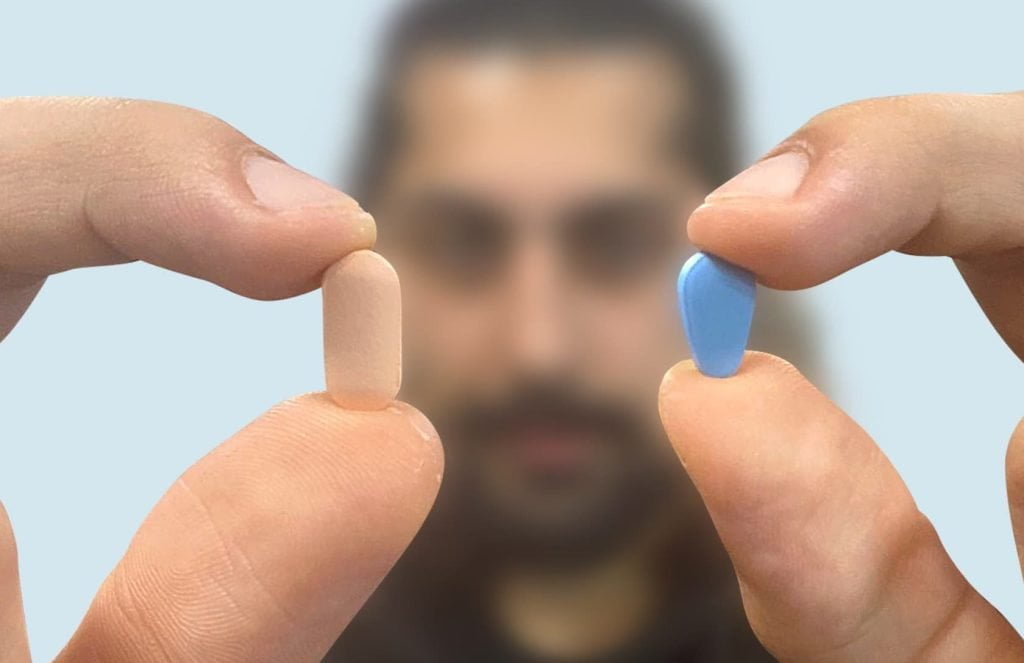PDE5 inhibitors like Tadalafil, found in Cialis, and Sildenafil, the primary ingredient in Viagra, are some of the most commonly used drugs to treat erectile dysfunction (ED).
Both Cialis and Viagra function similarly and significantly improve erections and sexual performance in men. But between Cialis and Viagra, which one is superior in terms of effectiveness, convenience, safety, and cost?
While Cialis and Viagra are quite alike, a few distinct differences might make one more suitable for you than the other. We have compared Cialis and Viagra based on several criteria such as their efficacy in treating ED, duration of action, and possible side effects. Continue reading to find out more.
What is Viagra?
Viagra is a popular brand-name medication used to treat erectile dysfunction (ED). It contains the active ingredient Sildenafil and was initially developed by Pfizer during the 1980s and early 1990s as a potential treatment for angina (chest pain associated with heart conditions).
The Food and Drug Administration (FDA) approved Viagra in 1998, making it the first prescription medication available for ED. It remains a widely used ED medication for millions of men facing erectile challenges.
Both Viagra and its generic version, Sildenafil, are available in oral tablet form. Viagra is typically taken as a pill prior to sexual activity. The standard dose of Viagra generally takes 30 to 60 minutes to work and helps in alleviating the symptoms of erectile dysfunction.
Note: Viagra is available in standard dosages of 25mg, 50mg, and 100mg.
What is Cialis?
Similar to Viagra, Cialis is a brand-name prescription medication approved by the FDA for treating ED. It contains Tadalafil as its active ingredient.
Tadalafil received FDA approval in 2003, and it is now more commonly known under the brand name Cialis. Like Viagra, Cialis is taken as an oral tablet before sexual activity.
Note: Cialis comes in standard dosages of 2.5mg, 5mg, 10mg, and 20mg.
How Cialis and Viagra Work
Both Cialis and Viagra work by inhibiting the action of an enzyme called Phosphodiesterase type 5 (PDE5) and activating nitric oxide in the body. This process relaxes the muscles in the penis, allowing increased blood flow during arousal.
Which Lasts Longer: Cialis or Viagra?
While Cialis and Viagra both aid in enhancing blood flow to the penis and treating ED, there is a substantial difference in the duration of their effects.
Cialis is known for its long-lasting effects and is often referred to as the “weekend pill” because it can remain effective for up to 36 hours. This prolonged action makes Cialis a convenient option for those who have ED but are unsure of the precise timing of sexual activity.
Conversely, Viagra is designed to be taken specifically before sexual activity to manage ED.
Does Food Influence the Effects of Cialis or Viagra?
Both Cialis and Viagra are broken down by stomach acids, which allows them to pass through the liver and enter your bloodstream.
Food does not influence the absorption of Cialis, so you can take your daily dose without worrying about meal timings. Cialis generally starts working within 30 minutes to an hour, even after a large meal.
On the other hand, food can significantly affect Viagra’s efficiency. While it is safe to take Viagra with food, consuming it after a high-fat meal (like fried foods or a cheeseburger) can delay the medication’s onset. It is advisable to consult your doctor about your diet while using Viagra.
Side Effects: Cialis vs. Viagra
Common side effects of Cialis include:
- Headache
- Dyspepsia (indigestion)
- Nasopharyngitis (nasal inflammation)
- Back pain
- Upper respiratory tract infection
- Facial flushing
- Myalgia (muscle pain)
- Cough
- Diarrhea
- Nasal congestion
- Pain in extremities
- Urinary tract infection
- Abdominal discomfort
- Gastroesophageal reflux disease
Most side effects associated with Cialis are minor and infrequent. Headaches are the most commonly reported side effect, experienced by about 15% of users.
Conversely, common side effects of Viagra include:
- Headache
- Facial flushing
- Dyspepsia (indigestion)
- Abnormal vision
- Nasal congestion
- Back pain
- Myalgia (muscle aches)
- Nausea
- Dizziness
- Skin rash
